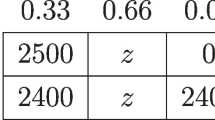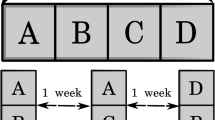Abstract
Our aim in this paper was to establish an empirical evaluation for similarity effects modeled by Rubinstein; Azipurua et al.; Leland; and Sileo. These tests are conducted through a sensitivity analysis of two well-known examples of expected utility (EU) independence violations. We found that subjective similarity reported by respondents was explained very well by objective measures suggested in the similarity literature. The empirical results of this analysis also show that: (1) the likelihood of selection for the riskier choice increases as the pair becomes more similar, (2) these choice patterns are consistent with well-known independence violations of expected utility, and (3) a significant proportion of individuals exhibit intransitive choice patterns predicted under similarity effects, but not allowed under generalized expected utility models for risky choice.
Similar content being viewed by others
REFERENCES
Allais, M. (1953), Le comportement de l'homme rationnel devant le risque: critique de postulats et axiomes de l'école américaine, Econometrica21, 503–546.
Azipurua, J.M., Ishiishi, T., Nieto, J. and Uriarte, J.R. (1993), Similarity and preferences in the space of simple lotteries, Journal of Risk and Uncertainty6: 289–297.
Bell, D.E. (1982), Regret in decision making under uncertainty, Operations Research30: 961–981.
Buschena, D.E. (1993), The effects of alternative similarity on choice under risk: toward a plausible explanation of independence violations of the expected utility model, Ph.D. dissertation, University of California at Berkeley.
Buschena, D.E. and Zilberman, D. (1995), Performance of the similarity hypothesis relative to existing models of risky choice, Journal of Risk and Uncertaint11, 233–262.
Buschena, D.E. and Zilberman, D. (1997a), A comment on ‘Investigating Generalizations of Expected Utility Theory Using Experimental Data’, by J.D. Hey and C. Orme. Working paper.
Buschena, D.E. and Zilberman, D. (1997b), Predictive value of predictive value of incentives, decision difficulty, and expected utility theory for risky choices, Working paper presented at the Foundations of Uncertainty and Risk VIII Conference, Mons, Belgium, July 1997.
Camerer, C. (1989), An experimental test of several generalized utility theories, Journal of Risk and Uncertainty2: 61–104.
Conlisk, J. (1988), Optimization costs, Journal of Economic Behavior and Organization9, 213–228.
Conlisk, J. (1989), Three variants on the allais example, American Economic Review79: 392–407.
Conlisk, J. (1996),Why bounded rationality? Journal of Economic Literature34: 669–700.
Fishburn, P.C. (1970), Intransitive indifference in preference theory: a survey, Operations Research18: 207–228.
Fishburn, P.C. (1988), Nonlinear Preference and Utility Theory, Johns Hopkins University Press, Baltimore.
Harless, D. (1992), Predictions about indifference curves inside the unit triangle: a test of variations in expected utility theory, Journal of Economic Behavior and Organization18: 391–414.
Harless, D. (1993), Experimental tests of prospective reference theory, Economics Letters43: 71–76.
Harless, D. and Camerer, C. (1994), The predictive utility of generalized expected utility theories, Econometrica62: 1251–1290.
Heiner, R.A. (1988), Imperfect decisions in organization: toward a theory of internal structure, Journal of Economic Behavior and Organization9: 25–44.
Hey, J.D. and Orme, C. (1994), Investigating generalizations of expected utility theory using experimental data, Econometrica62, 1291–1326.
Jensen, N.E. (1967), An introduction to Bernoullian utility theory, I: utility functions, Swedish Journal of Economics69: 163–183.
Kahneman, D. and Tversky, A. (1979), Prospect theory: an analysis of decision under risk, Econometrica47: 263–291.
Krantz, D.H. (1967), Rational distance functions for multidimensional scaling, Journal of Mathematical Psychology4: 226–245.
Leland, J.W. (1994), Generalized similarity judgments: an alternative explanation for choice anomalies, Journal of Risk and Uncertainty9: 151–172.
Loomes, G. and Sugden, R. (1982), Regret theory: an alternative theory of rational choice under uncertainty, Economic Journal92: 805–824.
Luce, R.D. (1956), Semi-orders and a theory of utility discrimination, Econometrica24: 178–191.
MacCrimmon, K.R. and Larsson, S. (1979), Utility theory: axioms versus ‘Paradoxes’, in M. Allais and O. Hagen (eds.), Expected Utility Hypothesis and the Allais Paradox, Reidel, Dordrecht, 333–409.
Mellers, B.S. and Birnbaum, M.H. (1982), Loci of contextual effects in judgment: human perception and performance, Journal of Experimental Psychology8: 582–601.
Parducci, A. and Perrett, L.R. (1971), Category rating scales: effects of relative spacing and frequency of stimulus values, Journal of Experimental PsychologyMonographs89: 427–452.
Payne, J.W., Bettman, J.R. and Johnson, E.J. (1988), Adaptive strategy selection in decision making, Journal of Experimental Psychology: Learning, Memory, and Cognition14: 534–552.
Radner, R. and Rothschild, M. (1975), On the allocation of effort, Journal of Economic Theory10: 253–262.
Rubinstein, A. (1988), Similarity and decision making under risk: is there a utility theory resolution to the Allais paradox? Journal of Economic Theory46: 145–153.
Rumelhart, D.L. and Greeno, J.G. (1971), Similarity between stimuli: an experimental test of the luce and restle choice models, Journal of Mathematical Psychology8: 370–381.
Sileo, P.W. (1995), Intransitivity of indifference, strong monotonicity, and the endowment effect, Journal of Economic Theory66: 198–223.
Sopher, B. and Gigliotti, G. (1993), Intransitive cycles: rational choice or random error? An answer based on estimation of error with experimental data, Theory and Decision35: 311–336.
Starmer, C. and Sugden, R. (1987), Violations of the independence axiom: an experimental test of some competing hypotheses, Discussion Paper No. 24, Economics Research Centre, University of East Anglia.
Tversky, A. and Kahneman, D. (1992), Advances in prospect theory: Cumulative representation of uncertainty, Journal of Risk and Uncertainty5: 297–323.
Viscusi, W.K. (1989), Prospective reference theory: toward an explanation of the paradoxes, Journal of Risk and Uncertainty2: 235–264.
von Neumann, J. and Morgenstern, O. (1953), Theory of Games and Economic Behavior, 3rd edn., Princeton University Press.
Wilcox, N.T. (1993), Lottery choice: incentives, complexity, and decision time, Economic Journal103: 1397–1417.
Author information
Authors and Affiliations
Rights and permissions
About this article
Cite this article
Buschena, D.E., Zilberman, D. Testing the Effects of Similarity on Risky Choice: Implications for Violations of Expected Utility. Theory and Decision 46, 253–280 (1999). https://doi.org/10.1023/A:1005066504527
Issue Date:
DOI: https://doi.org/10.1023/A:1005066504527




